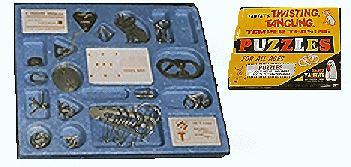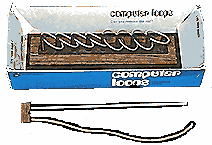
Manipulative puzzles made of wire, iron, tin, or other metals appear to have their origins in the mid-17th century according to Pieter van Delft & Jack Botermans (Creative Puzzles of the World, New York: Harry N. Abrams, Inc., 1978, page 143). The metal puzzle illustrated in the photograph at the left was purchased by the Museum in 1986. It is a contemporary copy of a hand-forged puzzle made in a nearby rural community whose local blacksmith fabricates many traditional metal puzzles from horseshoes.
The solution to this puzzle is "...done with some subtle bends and twists and careful manipulation of the four parts..." (Jerry Slocum & Jack Botermans, Puzzles Old & New, Seattle: University of Washington Press, 1992, page 98).
 Early in the 20th century, a number of manufacturing companies offered boxed kits of traditional wire puzzles. The pictured kit, manufactured by Spear Works in Bavaria, Germany, was purchased by the Museum in 1982. It includes 5 traditional puzzles: a Bent Nail Puzzle, a Double Ring Puzzle, a Heart Puzzle, a Loop Puzzle, and a puzzle similar to the blacksmith puzzle pictured above. The puzzles are of various sizes with the largest being 6cm long x 4cm wide. The box which holds the puzzles is 13.3cm long x 9.8cm wide x 1.7cm high.
Early in the 20th century, a number of manufacturing companies offered boxed kits of traditional wire puzzles. The pictured kit, manufactured by Spear Works in Bavaria, Germany, was purchased by the Museum in 1982. It includes 5 traditional puzzles: a Bent Nail Puzzle, a Double Ring Puzzle, a Heart Puzzle, a Loop Puzzle, and a puzzle similar to the blacksmith puzzle pictured above. The puzzles are of various sizes with the largest being 6cm long x 4cm wide. The box which holds the puzzles is 13.3cm long x 9.8cm wide x 1.7cm high.
 A similar puzzle kit was acquired by the Museum in 1987. Slocum & Botermans (page 96) illustrate a kit of this type that was first marketed in 1920 by the A.C. Gilbert Company who also marketed chemistry sets and construction sets for home use. The Museum's wire puzzle kit includes 20 puzzles, some composed only of wire, but a number also include pressed metal forms such as the Dog Puzzle (upper middle-right) and the traditional Horse-shoe Puzzle (middle-right).
A similar puzzle kit was acquired by the Museum in 1987. Slocum & Botermans (page 96) illustrate a kit of this type that was first marketed in 1920 by the A.C. Gilbert Company who also marketed chemistry sets and construction sets for home use. The Museum's wire puzzle kit includes 20 puzzles, some composed only of wire, but a number also include pressed metal forms such as the Dog Puzzle (upper middle-right) and the traditional Horse-shoe Puzzle (middle-right).
 Donated to the Museum in 1979, is this updated version of an ancient Chinese puzzle. In this contemporary version it is called Computer Loops, but in the past it has been called The Devil's Needle Puzzle, or just The Chinese Ring Puzzle (Slocum, page 105). Versions of this puzzle have been delicately carved from ivory, fabricated from wood, or like the one pictured to the left - made of metal and plastic. The base is 7.5cm wide x 32cm long x 5.6cm high. The plastic has a wood grain effect. Eight plastic black pegs sit on the base and hold a metal ring which overlaps the adjoining peg. The 9th peg is empty. A 27.4cm long metal and plastic rod with an attached string is used in solving the puzzle. The intent is to remove the rings, and the solution requires a large number of sequential movements to do this. In fact, Stewart Cullin, the noted 19th century American ethnologist (Games of The Orient, Rutland, Vermont, 1965), relates that the puzzle was invented by a famous Chinese general (about the 2nd century AD) as a present for his wife so that she would have something do while he was away at the wars!
Donated to the Museum in 1979, is this updated version of an ancient Chinese puzzle. In this contemporary version it is called Computer Loops, but in the past it has been called The Devil's Needle Puzzle, or just The Chinese Ring Puzzle (Slocum, page 105). Versions of this puzzle have been delicately carved from ivory, fabricated from wood, or like the one pictured to the left - made of metal and plastic. The base is 7.5cm wide x 32cm long x 5.6cm high. The plastic has a wood grain effect. Eight plastic black pegs sit on the base and hold a metal ring which overlaps the adjoining peg. The 9th peg is empty. A 27.4cm long metal and plastic rod with an attached string is used in solving the puzzle. The intent is to remove the rings, and the solution requires a large number of sequential movements to do this. In fact, Stewart Cullin, the noted 19th century American ethnologist (Games of The Orient, Rutland, Vermont, 1965), relates that the puzzle was invented by a famous Chinese general (about the 2nd century AD) as a present for his wife so that she would have something do while he was away at the wars!
NOTE: This page was originally created and posted on the Web on October 6, 1997. Subsequently it has been modified and periodically updated. Last update April 11, 2010